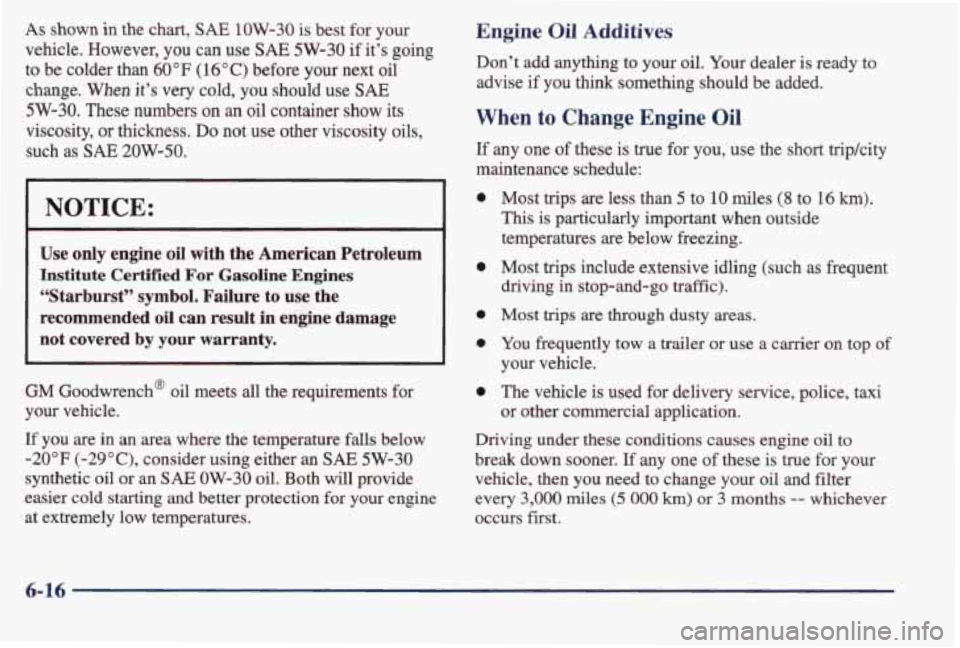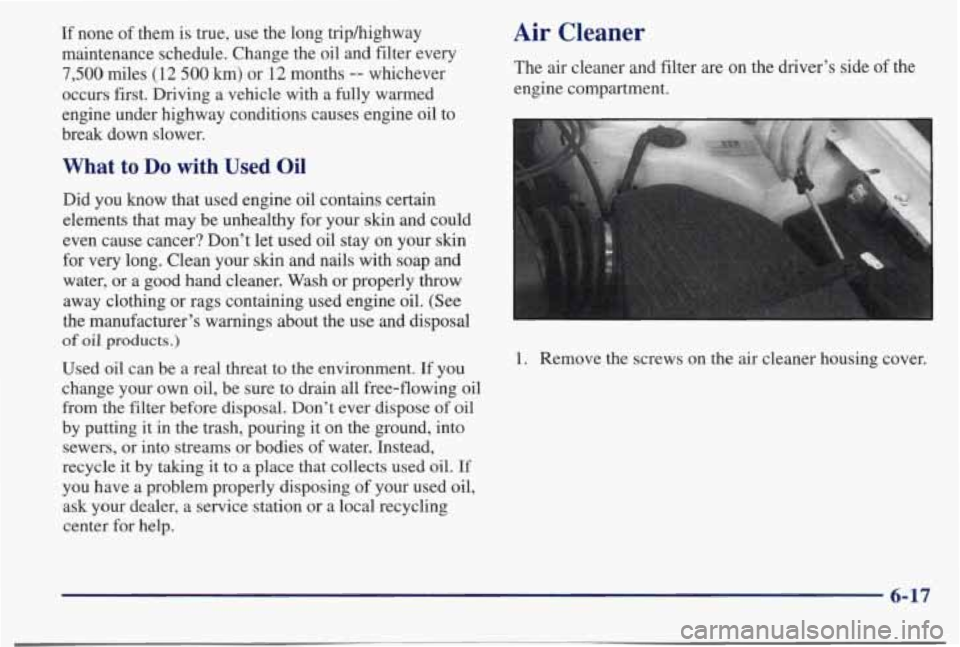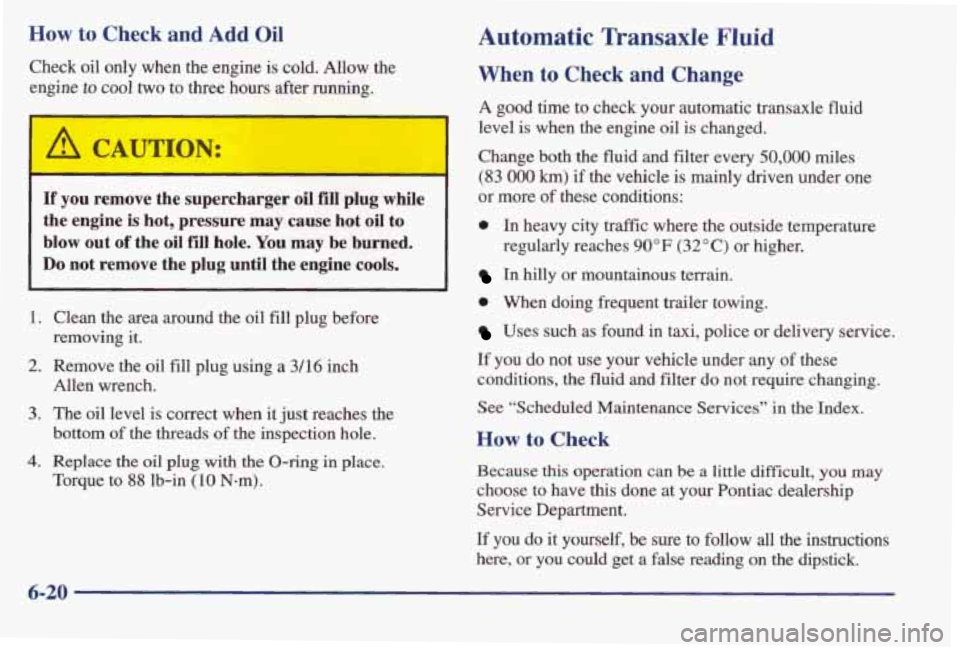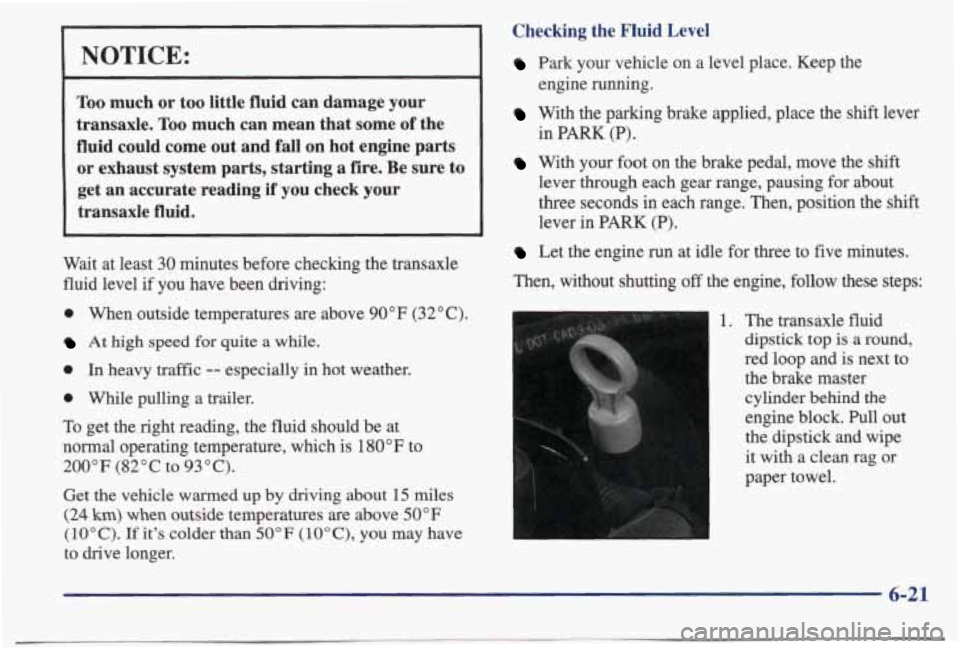Page 265 of 395
Checking Engine Oil
Pull out the dipstick and clean it with a paper towel or
cloth, then push it back in all the way. Remove it again,
keeping the
tip down, and check the level.
When to Add Engine Oil
If the oil is at or below the ADD mark, then you’ll need
to add at least one quart
of oil. But you must use the
right kind.
This part explains what kind of oil to use. For
crankcase capacity, see “Capacities and Specifications”
in the Index.
NOTICE:
Don’t add too much oil. If your engine has so
much oil that the oil level gets above the
cross-hatched
area that shows the proper
operating
range, your engine could be damaged.
The engine oil fill cap is behind the engine oil dipstick
and engine fans.
Be sure to fill it enough to put the level somewhere in
the proper operating range.
Push the dipstick all the
way back
in when you’re through.
6-14
Page 266 of 395
What Kind of Engine Oil to Use
Oils recommended for your vehicle can be identified
by looking for the "Starburst" symbol. This symbol
indicates that the oil has been certified by the American
Petroleum Institute
(API). Do not use any oil which
does not carry this Starburst symbol.
i A
If you change your own oil,
be sure you use oil that has the Starburst symbol on the
front of the oil container.
If
you have your oil changed
for you, be sure the oil put
into your engine is
American Petroleum
Institute certified for
gasoline engines.
You should
also use the proper viscosity oil for your
vehicle, as shown in the following chart:
RECOMMENDED SAE VISCOSITY GRADE ENGINE OILS
FOR BEST FUEL ECONOMY AND COLD STARTIN& SELECT THE LOWEST
SA€ VISCOSITY GRADE OIL FOR THE EXPECTED TEMPERATURE RAWGE.
HOT
WEATHER 7
"F
t 100 -
+80-
+60-
t40-
t 20 -
0-
7
"C
t3a
t
27
t 16
+I
-1
- 18
cou)
WEATHER
WOK
FOR THIS
SYMBOL
DO NOT USE SM 2QW-50 OR ANY OTHER GRADE OIL NOTRECaYlENMD
6-15
Page 267 of 395

As shown in the chart, SAE 1OW-30 is best for your
vehicle. However,
you can use SAE 5W-30 if it's going
to be colder
than 60 "F (1 6" C) before your next oil
change. When it's very cold, you should use SAE
5W-30. These numbers on an oil container show its
viscosity,
or thickness. Do not use other viscosity oils,
such as
SAE 20W-50.
NOTICE:
Use only engine oil with the American Petroleum
Institute Certified For Gasoline Engines
"Starburst" symbol. Failure to use the
recommended
oil can result in engine damage
not covered by your warranty.
GM Goodwrench@ oil meets all the requirements for
your vehicle.
If you are in an area where the temperature falls below
-20°F (-29"C), consider using either an SAE 5W-30
synthetic oil or an SAE OW-30 oil. Both will provide
easier cold starting
and better protection for your engine
at extremely low temperatures.
Engine Oil Additives
Don't add anything to your oil. Your dealer is ready to
advise if you
think something should be added.
When to Change Engine Oil
If any one of these is true for you, use the short tripkity
maintenance schedule:
0
0
0
0
0
Most tsips are less than 5 to 10 miles (8 to 16 lun).
This is particularly important when outside
temperatures are below freezing.
Most
trips include extensive idling (such as fiequent
driving
in stop-and-go traffic).
Most trips are through dusty areas.
You frequently tow a trailer or use a carrier on top of
your vehicle.
The vehicle
is used for delivery service, police, taxi
or other commercial application.
Driving under these conditions causes engine oil to
break down sooner.
If any one of these is true for your
vehicle,
then you need to change your oil and filter
every
3,000 miles (5 000 km) or 3 months -- whichever
occurs
first.
6-16
Page 268 of 395

If none of them is true, use the long triphighway
maintenance schedule. Change the oil and filter every
7,500 miles (12 500 km) or 12 months -- whichever
occurs first. Driving a vehicle with a fully warmed
engine under highway conditions causes engine oil to
break down slower.
What to Do with Used Oil
Did you know that used engine oil contains certain
elements that may be unhealthy for your
skin and could
even cause cancer? Don’t let used oil stay on your skin
for very long. Clean your
skin and nails with soap and
water, or a
good hand cleaner. Wash or properly throw
away clothing or rags containing used engine oil. (See
the manufacturer’s warnings about the use and
disposal
of oil products.)
Used oil can be a real threat to the environment. If you
change your own oil, be sure to drain all free-flowing oil
from
the filter before disposal. Don’t ever dispose of oil
by putting it in the trash, pouring it on the ground, into
sewers, or into streams or bodies of water. Instead,
recycle
it by taking it to a place that collects used oil. If
you have a problem properly disposing of your used oil,
ask your dealer, a service station or a local recycling
center for
help.
Air Cleaner
The air cleaner and filter are on the driver’s side of the
engine compartment.
1. Remove the screws on the air cleaner housing cover.
6-17
Page 269 of 395
2. Remove the air intake hose that is fitted over the
throttle body by pulling the hose upward and away
from the throttle body which is located near the top
of the engine.
3. Disconnect the electrical
connector which is
attached to the air
temperature sensor
located in the hose.
This will allow you to
lift
the rear portion of
the air cleaner.
4. After detaching the hose from the throttle body and
disconnecting the electrical connector, pull back the
entire rear portion of the air cleaner by pulling
upward and rearward.
5. Replace the air filter.
6. Reinstall the rear section of the air cleaner.
7. Reconnect the electrical connector.
8. Reattach the air intake hose.
Refer to the Maintenance Schedule
to determine when to
replace the
air filter.
See “Scheduled Maintenance Services” in the Index.
6-18
Page 270 of 395
/r CAUTION:
- I
Operating the engine with the air cleaner off can
cause you or others to be burned. The air cleaner
not only cleans the air, it
stops flame if the engine
backfires.
If it isn’t there, and the engine
backfires, you could be burned. Don’t drive with
it
off, and be careful working on the engine with
the air cleaner
off.
I NOTICE:
If the air cleaner is off, a backfire can cause a
damaging engine fire. And, dirt can easily get
into your engine, which
will damage it. Always
have the air cleaner in place when you’re driving.
Supercharger Oil
Unless you are technically
qualified and have the
proper tools, you should
let your dealer or a
qualified service center
perform this maintenance.
When to Check
Check oil level every 30,000 miles (50 000 km) or every
36 months, whichever occurs first.
What Kind of Oil to Use
See “Recommended Fluids and Lubricants” in the Index
and use only the recommended oil.
Page 271 of 395

How to Check and Add Oil
Check oil only when the engine is cold. Allow the
engine
to cool two to three hours after running.
If you remove the supercharger oil €ill plug while
the engine
is hot, pressure may cause hot oil to
blow out
of the oil fill hole. You may be burned.
Do not remove the plug until the engine cools.
1. Clean the area around the oil fill plug before
2. Remove the oil fill plug using a 3/16 inch
3. The oil level is correct when it just reaches the
bottom of the threads of the inspection hole.
4. Replace the oil plug with the O-ring in place.
Torque to
88 lb-in (10 N-m).
removing it.
Allen wrench.
Automatic Transaxle Fluid
When to Check and Change
A good time to check your automatic transaxle fluid
level is when the engine oil
is changed.
Change both the fluid and filter every
50,000 miles
(83 000 km) if the vehicle is mainly driven under one
or more of these conditions:
0 In heavy city traflic where the outside temperature
regularly reaches
90°F (32°C) or higher.
In hilly or mountainous terrain.
0 When doing frequent trailer towing.
Uses such as found in taxi, police or delivery service.
If you do not use your vehicle under any of these
conditions, the fluid and filter do not require changing.
See “Scheduled Maintenance Services” in the Index.
How to Check
Because this operation can be a little difficult, you may
choose to have
this done at your Pontiac dealership
Service Department.
If you do it yourself, be sure to follow all the instructions
here, or you could get
a false reading on the dipstick.
6-20
Page 272 of 395

NOTICE:
Too much or too little fluid can damage your
transaxle.
Too much can mean that some of the
fluid could come out and
fall on hot engine parts
or exhaust system parts, starting a fire. Be sure to get
an accurate reading if you check your
transaxle fluid.
I I
Wait at least 30 minutes before checking the transaxle
fluid level
if you have been driving:
0 When outside temperatures are above 90°F (32" C).
At high speed for quite a while.
0 In heavy traffk -- especially in hot weather.
0 While pulling a trailer.
To get the right reading, the fluid should be at
normal operating temperature, which
is 180 OF to
200°F (82°C to 93°C).
Get the vehicle warmed up by driving about 15 miles
(24 km) when outside temperatures are above 50°F
(10°C). If it's colder than 50°F (lO°C), you may have
to drive longer.
Checking the Fluid Level
Park your vehicle on a level place. Keep the
engine running.
With the parking brake applied, place the shift lever
in PARK (P).
With your foot on the brake pedal, move the shift
lever through each gear range, pausing for about
three seconds in each range. Then, position the
shift
lever in PARK (P).
Let the engine run at idle for three to five minutes.
Then, without shutting
off the engine, follow these steps:
1. The transaxle fluid
dipstick top is a round,
red loop and is next to
the brake master
cylinder behind the
engine block. Pull out
the dipstick and wipe
it with a clean rag or
paper towel.
6-21
-